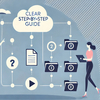
It is not necessarily fiction that you are going to write. It can be anything from your collection of posts in the travel blog to cooking experiments. Every experience deserves to be shared. However, when it comes to publishing, authors are often discouraged by the price of paperback copies.
It is usually here that the project stops. The price is too high, and with a few copies printed, you will hardly ever be able to compensate for the expenses, to say nothing of making your project profitable.
And this is where eBooks come in. Ebook writing can be a good solution to the problem of low budget. You can create an eBook for free, and this blog will teach you how to write a book online and avoid common mistakes.
Advantages of Ebooks
An eBook is a shortening for an ‘electronic book.’ It is a digital form of a printed version designed to be read on eReaders, PCs, tablets, or smartphones. Below are just a few advantages of eBooks for their creators:
- One of the advantages is that digital content can be stored in different formats. The most popular are PDF, ePub, Mobi, etc. The diversity of formats increases the potential target market.
- Some platforms offer eBook publishing in an audio format. This is an extremely effective way to attract new customers, as audiobooks are getting more and more popular.
- An eBook offers yet another way to enlarge your target audience. With an electronic book, you will get access to the most popular online markets. Your chances for success will increase, as you will get much more potential readers than in the case of selling hard copies. Just compare selling your masterpiece on Amazon and selling it in a bookstore in the neighborhood.
- If your book is the accumulated experience of your work, hobby, or business, it can serve as a good promotion of what you do. It will advertise your business to new customers, create a buzz, and make you a trendsetter.
- An eBook needs no time to be published and shipped to bookstores or customers. It is accessible via the Internet and saves you the costs of printing, storage, and shipment.
- Your eBook can be distributed a multitude of times. There is no such notion as the ‘number of copies printed.’ Your readers will get as many copies as they like without additional expenses on your part.
In addition to the advantages for the authors, electronic books offer great advantages for eBook readers:
- Electronic books can be bought at competitive prices. In fact, they are much cheaper than paperback versions.
- Some eBooks can be downloaded for free. You can find tons of free eBooks online, as many platforms offer them through advertising.
- Unlike paperback copies, eBooks can be accessed immediately. You no longer have to wait for your order or go to the bookstore.
- Ebooks will take up no room on your bookshelves. They weigh nothing and are incredibly portable (they can be stored on any device).
- Ebooks make reading more convenient, as you can change (increase or decrease) the font sizes.
Another advantage for both authors and readers is that digital books are environmentally friendly. The production of eBooks does not imply the consumption of any resources except the electricity you need to charge your eReader.
Steps to Create an Ebook
Though writing and publishing a book is a creative process, there are some steps that are repeated by most authors.
- Writing starts with choosing a topic. In most cases, it happens spontaneously. Your future book will most probably be dedicated to your hobby, business, children, pets, or some other activities that you think deserve to be described.
- In the second step, people usually make an outline. It can be detailed or general. Some authors just highlight some points, while others outline each future chapter of the eBook.
- Then goes content creation. You have to fill each chapter with information.
- Design is what you do next. Design is not only about fonts, backgrounds, and colors. Each book has to be structured. Pull quotes, spaces, and margins matter.
- Next step is visuals. These can be drawings (if your eBook concerns engineering and design), charts and graphs (if it is about economics), or illustrations (if it is fiction). The latter may cause certain problems concerning copyright. Remember that you cannot just take any illustration you like from the Internet. However, you can take almost any picture or drawing you like, which is over 50 years old. Anyway, the platform you are going to publish with is sure to have a reviewing process, and the reviewer will ban the illustrations that don’t follow the copyright rules.
- If your eBook is part of a larger business project, it is advisable to place links to other relevant materials or information in the text. These can be regarded as calls-to-action, as such links can lead the reader to your online shop or some other page where some action is required from the reader, like buying or donating, etc.
- You may work on your book in any format you like, but when you are finished, you will have to convert it into a PDF file. Otherwise, the changes you’ve made may be lost in uploading the content to the publishing platform.
- It is great if you make a landing page for your eBook. This is important if you want your readers to get the right information about your book. Besides, having a landing page is convenient in terms of promotion. You can always give a link to this page and save your readers the time they will spend searching for the info on the net.

Best Tools to Create an Ebook
Today, you can find many eBook creator tools on the internet. Everyone is familiar with Google Docs, which looks almost like Microsoft Word and is as simple to work with. The bonus you can get with Google Docs is saving your content in two formats, PDF and ePub.
The same can be said about Pages, though it is mainly used by Mac users. PDF and ePub formats are also available here.
Draft2Digital is a tool for online publishing and a distribution platform that offers you eBook creation and publishing tools for free, and also a distribution service. You will be able to publish your book on the most popular online markets by paying just 10% of your retail book price to D2D.
Vellum is a software tool for Mac users. It allows you to export your manuscript in ePub (if you want to publish an eBook) and PDF format (if you want a printable version). It is a powerful tool with many features that you will find handy. However, it is free only for PDF format. If you want to publish in ePub, you will have to subscribe to a premium version.
Kindle Create is almost as popular as Vellum. Its indisputable advantage is that it is designed both for PC and Mac. The program itself is free and is integrated with the Kindle Direct Publishing Platform. A major drawback users often complain of is that with Kindle Create you can save only to two formats – KPB (KeypadBuilder Project) and KPF (Kindle Package Format).
ClickHelp is an online documentation management platform based on the principles of single sourcing and content reuse. It means that you can easily adapt your book to different audiences. You can get different ‘editions’ of your content at a time.
For instance, you have a basic book version about traveling to all states of the African continent. However, part of your audience is interested only in Northern Africa, the so-called Maghreb countries.
Using snippets and variables, you can change the content of the basic book so that only the chapters concerning the Maghreb are visible. This is convenient when your target audiences have different interests and tastes.
With ClickHelp, you can store your content in a cloud and publish it in PDF format when your eBook is ready. Thus, you will make sure that all changes concerning design are preserved.
ClickHelp provides ready-made templates that will make your eBook look attractive. If the templates are not enough or you want to introduce some changes that are not covered by templates, the looks of your eBook can be adjusted via CSS files.
How to Format an Ebook for Publishing?
Most publishing platforms inform their users that they can just upload a Word document, and all changes will be preserved. However, it works only when the author hasn’t made many adjustments related to the design. In most cases, you will have problems formatting books after uploading them to the platform.
These problems may concern page numbers in the table of contents. This is mostly because page lengths depend on device type, and what is good for eReader may not work for the smartphone. The best advice here is to remove page numbers from the TOC and make sure that the links work and lead directly to the necessary place in the text.
Another thing is using headings and subheadings. Some publishing platforms may not understand these subdivisions correctly, and some of your headings may remain non-hyperlinked. So, make sure your index is clear and simple. Don’t make too many subchapters.
Great Ebook Examples
If you use ClickHelp for writing an eBook, make use of the free eBooks you can find on the platform. The books are available here.
If your future eBook concerns IT, design, engineering, marketing, economics, or any other technical field, these eBooks will help you create great content and publish it on the platform. Here you can find the essential information from a practical course on technical writing (Technical Writer Career Guide) to a guide on technical documentation types (Types of Technical Documentation).
You will also get an in-depth investigation of the way tech writing and SEO are interrelated (SEO and Technical Writing). This will teach you how to enhance the ranking of your content in search engine results. You will also learn about readability metrics (Technical Writing: Readability and Text Metrics) and much more.
In the ClickHelp blog, you will also find information on other books and writers devoted to tech writing that you may find useful for creating your own eBook.

Conclusion
If you cannot afford to publish a book in paperback but still want your knowledge and experience shared and distributed, an eBook will be a great solution. It will help to collect your knowledge in one source and provide it with a flexible form that will make it easy to be accessed and used by readers.
An eBook is capable of transforming your business and giving it a new life. A book will change your approach to advertising. It will no longer look spammy but will give a solid look to everything you do. It will attract new customers and finally bring you to a level where you will see your books in paperbacks in the most popular bookstores.
Good luck with your technical writing!
ClickHelp Team
Author, host and deliver documentation across platforms and devices


